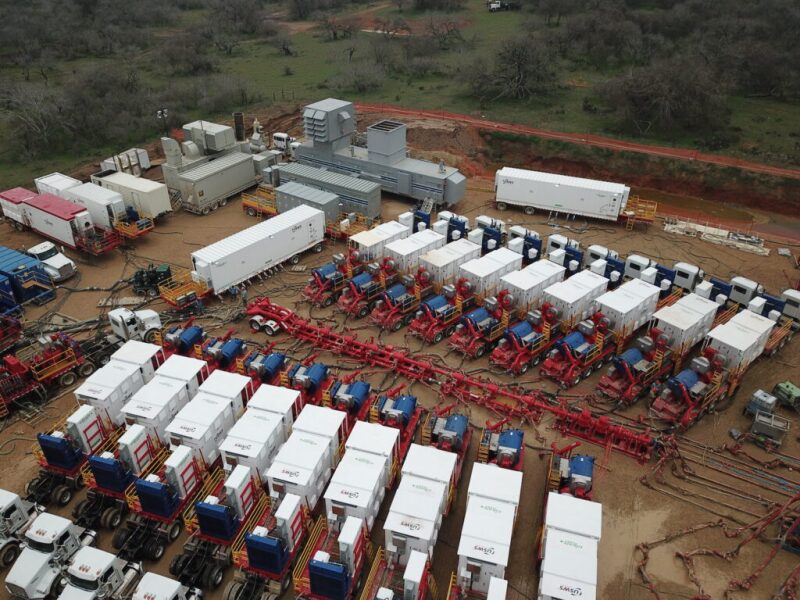US service companies are sending hydraulic fracturing units into overflowing equipment yards at the fastest clip ever seen. But one thing not likely to be found at these sites are the recently emerged electrically powered fracturing units, or “e-fleets.”
At the start of the year, there were about 290 active fleets of all flavors spread across the country, according to figures from Primary Vision. The firm, which publishes the US frac count weekly, estimates the active number was down to 47 at the end of last week—15 of which are believed to be e-fleets.
“It’s amazing that [e-fleets] accounted for roughly 3% of the market about 2 months ago and now they’re potentially about 30%,” said Matt Johnson, the president and chief executive of Primary Vision.
Three companies own this entire space which has been driven by the shale sector’s growing concerns over noise levels, fuel costs, and carbon footprints. Evolution Well Services and US Well Services, both based in the Houston area, each are estimated to be operating six electric pumping spreads. Midland-based ProPetro operates the remaining three e-fleets.
E-fleets are called so because they use gas-powered turbines to generate electricity that is then used to run the pumps. The approach means only eight to 10 pressure pumping units are needed on location whereas the typical deisel-powered spread requires around 20 units to treat a well. Using gas also generates meaningful fuel savings and a reduction in the emissions intensity of each well completion.
The biggest reason that e-fleets have not seen greater adoption in recent years is their cost, which is widely understood to be at least twice that of a traditional diesel-powered fleet.
In an ironic twist, those big price tags are now the most likely reason why the e-fleets are proving to be more resilient amid what is otherwise a total market collapse. To take on the risk and cost of building out a new e-fleet, service companies typically require multiyear contracts from their operator clients.
US Well Services said in its most recent earnings call this week it signed a 3-year contract for electric fracturing services with gas shale producer EQT Resources which operates three of its electric fleets plus one conventional spread. This deal was struck after the pressure pumper brought on its sixth e-fleet to work for Shell in January. The e-fleets, which run about $13 million each, now represent two-thirds of the company’s entire working asset base.
ProPetro launched its first electrically powered pumping units in January. Last year, the company reported the first two of these fleets were contracted by ExxonMobil (XTO Energy) and Diamondback Energy.
“They believe in the technology,” said Phillip Gobe, the executive chairman of ProPetro during the firm’s most recent earnings call. “I think they believe that going forward, we are going to be in a lower-priced world. They need new technology that’s more efficient, less people, less cost to run, and they are willing to let us bring it out and continue.”
Johnson noted that Evolution—which operates e-fleets exclusively—may hold a competitive edge amongst its peers since it has four dedicated fleets operating with EOG Resources. “As of this past week, EOG might be the only operator in the Eagle Ford still fraccing and it's with an electric spread,” he said, adding that all of the 15 active e-fleets are expected to remain fully utilized for the foreseeable future.
Evolution highlighted that in addition to long-term contracts, chief to its strategy of weathering the cyclical pumping business is to diversify where it operates. Carrie Murtland, the chief operating officer of Evolution, said a third of the firm’s fleets are working in the Marcellus and Utica basins.
“The bifurcation between oil and natural gas economics is glaringly evident today,” she said. “A portion of our clients are evaluating what their production plans look like with WTI tumbling to negative values, meanwhile customers in the natural gas business have growing excitement around $3.00-plus gas futures.”
One big question around this development is whether it is a trend or an anomaly exposed by extraordinary events. Murtland cautiously pointed out that the answer depends entirely on the shale sector’s ability to spend cash—and whether those new dollars go to the higher-cost e-fleets.
“Currently, nearly all electric fleet capacity is being utilized, meaning that if overall completions activity utilization does rise in the future, electric providers would be required to deploy new fleets in order to maintain the sudden market share gains that we have seen recently,” she said. “From Evolution’s perspective, we continue to have a watchful eye on the market and will defer any decision to invest further into horsepower growth until we have a clearer picture of how activity and service pricing will unfold.”


